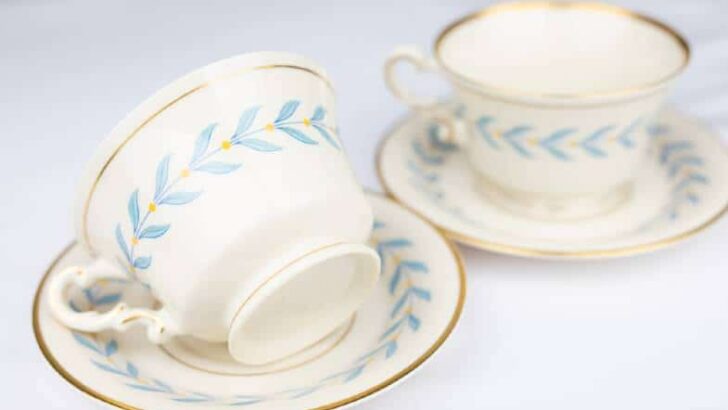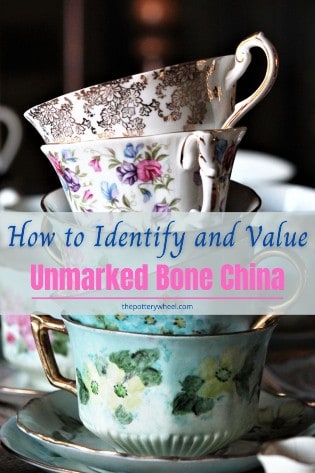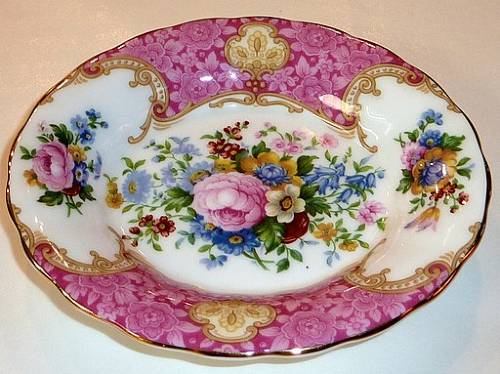Your cart is currently empty!
Bone China With No Markings – Sizing Up Unmarked China
Published:
Last Updated:

Affiliate Disclaimer
As an affiliate, we may earn a commission from qualifying purchases. We get commissions for purchases made through links on this website from Amazon and other third parties.
Manufacturer’s markings were introduced in 1850. They help in identifying and evaluating bone china dinnerware. Hence, bone china with no markings is challenging to assess and determine its origin.
Antique or early bone china pieces don’t have markings since bone china was created in 1748 before producers introduced marks and stamps. In addition, some fresh sets lack or have difficult-to-read markings due to fading, staining, or worn out of the item as markings’ longevity depends on the item’s age and how it was preserved.
However, you can identify unmarked bone china by examining the design style features of the patterns. For example, many pieces are soft, white, and ivory with gold-plated borders or handles adorned with gold leaf, hand-painted designs, or both. Moreover, a professional appraiser can identify and evaluate the unmarked ancient or fresh bone china.

Overview of Bone China With No Markings
Most chinas have identification marks that provide information about the piece’s manufacturer and its country of origin. On the other hand, back stamps can tell you how old a piece is since most producers changed tableware’s back stamps every few years.
Most printed or stamped markings were most likely dated after 1850 whereas marks were introduced from 1891. So, if dishware includes a signature or stamp on the bottom, it was most likely made in the 1800s.
Therefore, the initial few pieces of bone china may not have had a mark or stamp since bone china has been around even before the 1800s and has historically been passed down through generations.
Regardless, pieces that don’t have marking are not necessarily old. There are cases where the dinnerware’s markings have faded or worn out due to improper maintenance, over usage, or age.
How to Identify Unmarked China
Identification of unmarked bone china is vital as it will help you understand its historical significance and value. Unfortunately, since markings help determine the manufacturer and age of the piece, unmarked porcelain may be challenging to recognize.
However, by following some of the following steps you might be able to determine whether your kitchenware is authentic bone china.
Determine if it’s Bone China
Before you determine the maker and type of unmarked bone china, determine what kind of china you have because there are numerous types of chinaware, each with its manufacturing method.
First, pick up the piece and check on its breadth and heaviness. Compared to other porcelains, bone china dinnerware is clearly distinguished by its beautiful thinner shape and as well as being lightweight.
Place the piece in front of a light source. According to Noritake, bone china has higher translucence compared to other porcelains. If you place an open palm behind it, you will see shadows of your fingertips through it. The latter also helps to determine if it’s genuine.
Note the background color- bone china tends to have an ivory or off-white hue. If the piece is entirely white, then it is mainly made of hard or soft porcelain.
Establish a Pattern
Examine the ceramic item for traditional bone china design styles to determine the pattern type:
Gold edge: When you look at some bone china patterns, you’ll first notice gold or gilt edges. The lovely gold color is typically applied to the edges of dinnerware.
Primary Color: The primary color for all bone china is creamy-white. However, there might be different colors in the design. Gold, pink, blue, black, and red are some of the colors you may notice.
Specific pictures in the pattern: Consider checking for mainly floral and leaf designs. There might also be patterns with ladies or pictures of individuals, animals, or birds.

Tangerineduel, CC BY-SA 4.0, via Wikimedia Commons
Compare Patterns
Many patterns are exclusive to specific manufacturers. Examine the distinguishing elements, like borders, corner work, form, and aesthetic flourishes, and check their consistency. In many situations, the colors will help you establish the era or even the pattern’s name. Moreover, specific design trends were historically more popular than others.
Several websites and auction sites have a lot of material published online about them. These sites are dedicated to selling or assisting in the identification of china sets. The Spode Collection and Robbin’s Nest Noritake Directory are types of manufacturers’ websites you can use.
You can also read reference books containing extensive bone china information. You may also visit a library or the antiques/collectibles department of your local bookstore.
Another option is to look for a respectable appraiser, dealer, or auctioneer that evaluates or sells items comparable to yours at flea markets and art fairs that might be able to assist you in identifying yours.
Dating Unmarked Bone China Pattern
Dating is a crucial aspect of identifying dinnerware. Patterns have often remained in continuous production for decades in many situations. Determine the most likely time frame for the production of your tableware.
Many producers created dozens, if not hundreds, of distinct designs at different times. For instance:
- 1900-1920 Dinnerware had flower designs with violets and pastel hues and was ringed with a curved edge.
- Designs from 1920 to 1940 had vivid colors and geometric forms. Pastel hues and ivory or cream white items with gold or silver plating were still popular at the time.
- Designs from the 1940s through the 1950s mostly used lots of bright hues like red, blue, and green. Pastels were uncommon during this period. The most common form during this period was rimless and sleek.
- Gold trim was seldom used in designs in 1950-1970. Pastels resurfaced in favor, although they were more subdued than previous tableware.
Sometimes a piece of tableware appears to be from several distinct eras. However, once you’ve narrowed your options down, you may compare your work to others from that time. If you find a lot of comparisons, chances are the item was made around that time.
How to Value Your Unmarked Bone China
Once you’ve determined the age and pattern, the next thing is to determine its approximate worth. You may check up the piece’s approximate worth online or take it to a competent assessor to establish the exact value.
Tip: Just because a piece of ceramic china tableware appears to be antique does not make it valuable. The more the dinnerware set’s completeness, the better its condition, and the scarcity of ancient china dishware, the more valuable it is.
You may read reference books containing particular piece values at your local library or bookshop. You may also check for a similar or nearly identical piece on websites or auction sites and see what it is selling for. However, these techniques may not reflect genuine worth as they offer a basic notion.
An excellent approach is to contact someone who specializes in ceramics and exquisite chinaware. Give the professional a thorough description of the item as well as an image of it. If the specialists can identify the piece as genuine, they may also provide you with the current worth.
Final Thoughts
Bone china with no markings can be distinguished by looking for pattern designs and styles such as gold edging, white, ivory background color, and specific images of things or individuals. Its origin can be determined by comparing the piece’s pattern with patterns on the internet, books with porcelain information, and consulting collectors, auctioneers and appraisers.
You can determine the historical significance and worth of an unmarked bone china piece through internet sources and reference books. However, we highly recommended contacting an appraiser that will inspect the item and give you an actual value.



